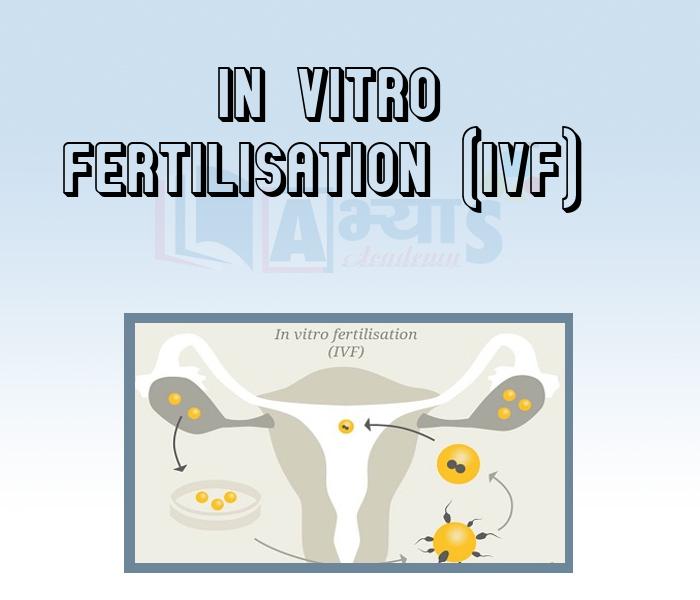In Vitro Fertilisation -IVF








In Vitro Fertilisation - IVF
In a healthy woman, the fertilisation of egg by the sperm takes place in the oviduct (or fallopian tube). The oviducts of some women are blocked due to some reasons. Such women cannot produce babies in the normal way because the eggs released by their ovary cannot meet the sperms and get fertilised in the oviducts (because the oviducts are blocked). Such women wwho cannot produce babies are called sterile. Even sterile women can have babies by using the 'in-vitro fertilisation' technique. In vitro fertilisation' means "in glass fertilisation'. This is because in this technique, fertilisation of an egg with sperm is carried out in a 'glass dish' or a 'glass tube' rather than in the body of a woman. This is commonly known as 'test-tube baby' technique. In Vitro Fertilisation is known as IVF in short. The in vitro fertilisation technique helps the woman with blocked oviducts in having babies as follows: 1. The eggs are removed from the oyary of woman by laproscopy. In this operation, a small cut is made in the side of woman's abdomen and an optical fibre tube is inserted into her body so that the doctor can see the ovary and take out the tiny egg 2. The woman's husband provides the sperms (in the form of semen). 3. The sperms are mixed with eggs in a glass dish (or glass test-tube) to carry out fertilisation. The fertilised eggs (or zygotes develop into embryos. 4. After about a week, one or more embryos are placed in the woman's uterus (or womb). If the embryo gets implanted in the uterus successfully, then normal pregnancy occurs and a baby is born after about nine months. In vitro fertilisation (IVF) technique is used to help those couples (husbands and wives) in having babies who can produce sperms and eggs but fertilisation cannot take lace inside the woman's body due to blocked oviducts (or blocked fallopian tubes). The 'in vitro fertilisation' technique was initially developed for carrying out the reproduction in farm animals (like cows and buffaloes) in 1950. This technique was used successfully for reproduction in humans in 1978. A lårge number of babies are now born in our country by using this IVF technique. The success rate of this technique is only about 30 to 40 per cent. The babies born through in vitro fertilisation technique are celled test-tube babies because the fertilisation takes place in a glass dish or a glass test-tube. This is, however, a misnomer (wrong name) because except for a very brief period of about one week of fertilisation and very early development (which is spent in a test-tube), almost the entire growth and development of the baby takes place inside the uterus of the woman as in normal pregnancy.Which of the following are correct : (a) Sterile women can have babies by using the 'in-vitro fertilisation' technique. (b) In vitro fertilisation' means "in glass fertilisation'. (c) The eggs are removed from the ovary of woman by laproscopy. | |||
| Right Option : D | |||
| View Explanation | |||
The 'in vitro fertilisation' technique was initially developed for carrying out the reproduction in _________________ in 1950. | |||
| Right Option : D | |||
| View Explanation | |||
In in - vitro fertilisation, the sperms are mixed with eggs in a ___________________ to carry out fertilisation. | |||
| Right Option : C | |||
| View Explanation | |||
Students / Parents Reviews [10]
It was a good experience with Abhyas Academy. I even faced problems in starting but slowly and steadily overcomed. Especially reasoning classes helped me a lot.

Cheshta
10thOne of the best institutes to develope a child interest in studies.Provides SST and English knowledge also unlike other institutes. Teachers are co operative and friendly online tests andPPT develope practical knowledge also.

Aman Kumar Shrivastava
10thBeing a parent, I saw my daughter improvement in her studies by seeing a good result in all day to day compititive exam TMO, NSO, IEO etc and as well as studies. I have got a fruitful result from my daughter.

Prisha Gupta
8thAbhyas is a complete education Institute. Here extreme care is taken by teacher with the help of regular exam. Extra classes also conducted by the institute, if the student is weak.

Om Umang
10thMy experience with Abhyas is very good. I have learnt many things here like vedic maths and reasoning also. Teachers here first take our doubts and then there are assignments to verify our weak points.

Shivam Rana
7thA marvelous experience with Abhyas. I am glad to share that my ward has achieved more than enough at the Ambala ABHYAS centre. Years have passed on and more and more he has gained. May the centre flourish and develop day by day by the grace of God.

Archit Segal
7thIt has a great methodology. Students here can get analysis to their test quickly.We can learn easily through PPTs and the testing methods are good. We know that where we have to practice

Barkha Arora
10thMy experience with Abhyas academy is very good. I did not think that my every subject coming here will be so strong. The main thing is that the online tests had made me learn here more things.

Hiya Gupta
8thI have spent a wonderful time in Abhyas academy. It has made my reasoning more apt, English more stronger and Maths an interesting subject for me. It has given me a habbit of self studying

Yatharthi Sharma
10thIt was good as the experience because as we had come here we had been improved in a such envirnment created here.Extra is taught which is beneficial for future.
